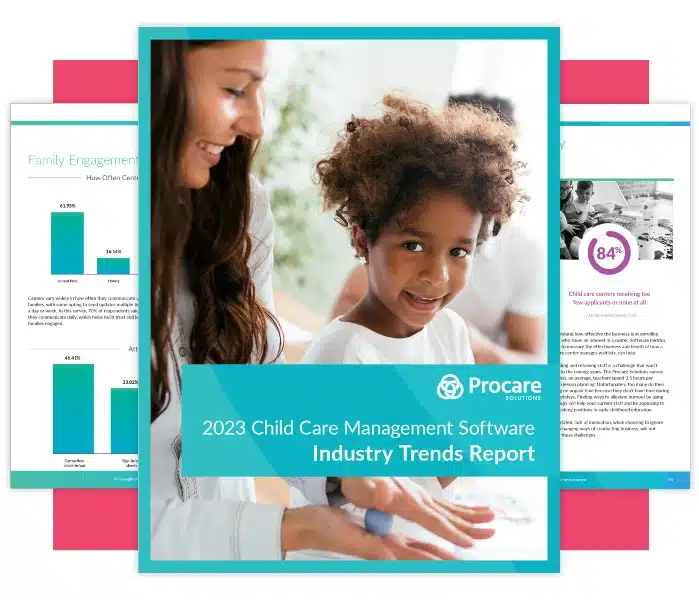
Child care nutrition standards are set by the federal government to help make sure child care and daycare centers are providing adequate nutrition to kids in their care. Offering a nutritious food program is how you can meet these standards, which outline early childhood education nutrition guidelines for serving healthy, balanced meals.
Along with providing nutritional best practices, these government nutrition standards are a great starting point for planning meals for kids in your child care center.
Mealtimes at your center are about more than food, though! They are an important opportunity for children to learn to enjoy a variety of foods, develop motor skills, learn more about food and where it comes from and to socialize with adults and other children.
Discovering the pleasure of healthy eating and observing good food practices in adult role models sets kids up to develop positive lifelong habits and attitudes around food.
Let’s take a deeper look at how you can ensure the meals and snacks at your center meet nutritional guidelines and best practices.
U.S. Child Care Nutrition Standards
Nutrition standards for child care centers are set by the U.S. Department of Agriculture. The USDA’s Child and Adult Care Food Program (CACFP) offers reimbursement to child care and adult day care centers for serving nutritious meals and snacks.
To be eligible for reimbursement, a meal must meet CACFP nutrition guidelines. Child care centers can claim up to two reimbursable meals and one snack, or two snacks and one meal per each eligible child, every day.
The CACFP gives guidelines to help care providers make healthy choices for kids by including various food groups and adjusting serving sizes by age. All meal components are to be served in a specific portion size depending on the child’s age group.
Breakfast, lunch, dinner, and snacks each follow different guidelines for children:
- Breakfast should include portions of fluid milk, grains and fruits or vegetables
- Lunch and dinner should include portions of fluid milk, meat or meat alternatives, grains, fruits and vegetables
- A snack should include portions of at least two of the following: fluid milk, meat or meat alternatives, grains, fruits and vegetables
The program also outlines requirements for reducing sugar consumption and emphasizing a varied diet. For instance, there are limitations on the use of juice for a fruit serving, and cereals and yogurts must be low in sugar. At lunch and dinner, a vegetable may be used to fulfill the fruit requirement, but two different vegetables must be served rather than a double helping of one vegetable.
7 Best Practices for Child Care Nutrition

The USDA provides a list of best practices that child care providers should follow to ensure kids are getting the most benefit from the meals they enjoy while in daycare.
Our list of seven best practices combines recommendations from the USDA with insights from Procare Solutions on how to enhance nutritional practices in your child care.
1. Serve a Variety of Foods
Serving a variety of foods helps to ensure that kids get all the essential nutrients they need to grow up healthy and strong. It can also play a role in supporting gut health, heart health and strengthening the immune system.
The USDA recommends that child care centers serve a fruit or vegetable as one of the two required components of each snack and choose whole fruits and vegetables more often than juice. It also suggests providing at least one serving per week of:
- Dark green vegetables (broccoli, spinach, kale, etc.)
- Red and orange vegetables (red peppers, carrots, sweet potatoes, etc.)
- Beans and peas (green or yellow string beans, green peas, etc.)
- Starchy vegetables (corn, potatoes, parsnips, etc.)
- Other vegetables (celery, asparagus, cauliflower, etc.)
2. Model Positive Eating Habits
Children learn their attitudes to food from the adults around them. A family-style dining environment where staff choose from the same healthy meal options as children and engage with kids while avoiding screens helps to reinforce healthy choices and eating behaviors in kids.
3. Teach Kids about Hunger Cues
Kids are learning their food preferences and hunger signals, and this should be respected and encouraged.
Encouraging kids to continue eating when they are full, coercing kids into eating foods that they don’t like or want or using food as a reward can foster a unhealthy attitude toward eating. Instead, child care providers should let kids decide how much and what to eat.
4. Avoid Serving Foods with Excess Sugar
According to the CACFP, child care providers should avoid serving foods that contain added sugar. This includes sweet toppings like honey, jam, syrup and candy. But the main ones to watch out for are sugary beverages.
Sugar-sweetened beverages include:
- Fruit juices
- Sodas
- Iced tea or sweetened tea
- Sports drinks
- Energy drinks
- Flavored milks (chocolate, strawberry, etc.)
Sugar-sweetened beverages are a non-nutritive source of excess sugars that have been linked with several adverse health outcomes in adults, including diabetes, heart disease and obesity. Focus on serving kids water or white milk instead of sugar-sweetened beverages.
5. Remember Food Safety

Children under 5 are more likely to get sick and develop a more serious illness from food poisoning than adults. To protect kids, child care providers need to follow the appropriate food safety measures at all times. These include:
- Washing hands, kitchen utensils and kitchen surfaces before preparing meals
- Keeping raw meat, chicken, seafood and eggs separate from other foods during preparation
- Cooking foods to the appropriate internal temperature to kill germs
- Refrigerating perishables and leftovers within one hour to prevent bacterial growth
6. Train and Educate Staff about Nutrition
A healthy diet begins with educated child care staff who understand how to choose and prepare healthy meals, read nutrition labels and follow the latest science on nutrition.
Ongoing professional development will help the staff at your center provide first-class nutrition to kids.
7. Support Breastfeeding
The American Academy of Pediatrics recommends exclusive breastfeeding for the first six months of life, then another six months of breastfeeding while introducing complementary foods.
Child care centers should work to create a safe, quiet and private area for mothers who visit the center to breastfeed. You can also encourage moms to supply breast milk that can be stored for later use.
Child care providers should keep in mind that not all mothers can or choose to breastfeed, or perhaps they do a hybrid formula-breastmilk approach. It’s important to support mothers and caregivers in whatever way they feed their infants.
How Procare Can Help!

Experienced child care providers know — and science confirms! — that healthy diets lead to healthy, happy kids who learn, play and socialize at their best.
Providing a balanced and nutritious diet is just one of the things you do to make sure your center is the best place for kids to grow and thrive.
For more than 30 years, Procare Solutions has been helping early childhood educators do this by simplifying operations and creating meaningful connections with families so they can focus on what matters most — the children in their care.
Whether you are feeding 15 children in your home or 150 children across multiple locations, Procare gives you the tools you need to easily track meals served for breakfast, lunch, dinner and snacks. You can record meal counts based on child schedules or actual attendance, as well as log information such as free, reduced or paid statuses with meals claimed for reimbursement versus non-eligible meals.
You also can print classroom meal rosters, menus and meal count reports based on age groups. A variety of food program reports are available within Procare!
From registration, attendance tracking, staff management and lesson planning to family engagement, tuition collection and reporting, Procare Solutions helps ease the challenges faced with running a child care business.
Want to know how much time and money you could save by using the Procare all-in-one solution to run your child care center, including help with meal planning? Enter some details into this online calculator to learn about your potential savings of using automation!



